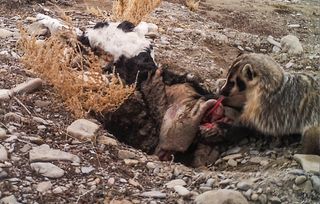Little Badger Buries Entire Cow — on Camera

An industrious badger in Utah's Great Basin Desert was caught on camera burying a cow four to five times the little animal's own size.
The behavior has never been seen in the wild, and it was a total surprise to the researchers who accidentally captured time-lapse video of the burial, the scientists said. It was particularly surprising because they were attempting to study scavenging birds, not badgers, the researchers said. The badger spent five days excavating a hole around the cow carcass and burying the animal in it, before lolling around near its cache of food for weeks.
"Not to anthropomorphize too much, but he looks like a really, really, happy badger, rolling in the dirt and living the high life," University of Utah doctoral candidate in biology Evan Buechley, who discovered the footage, said in a statement. [Watch the Video of the Badger Burying a Cow Carcass]
Missing body
To document the behavior of scavengers like vultures, Buechley dragged seven calf carcasses out to the Grassy Mountains west of Salt Lake City. He and his colleagues set up camera traps by the staked-down carcasses so they could monitor what kind of scavengers visited. After a week, Buechley returned to the study site and found only six carcasses.

"When I first got there, I was bummed, because it's hard to get these carcasses, to haul them out and set them up," he said. He said he figured a coyote or mountain lion had dragged the body away. [Beastly Feasts: Amazing Photos of Animals and Their Prey]But then he noticed that the dirt was disturbed where the carcass had been lying.
"Right on the spot, I downloaded the photos," he said.
Badger surprise
What he saw was a five-day time-lapse of a badger (Taxidea taxus) completely burying the calf carcass, caught by the camera trap that was programmed to go off upon detecting movement. The cow weighed about 50 lbs. (23 kilograms), and badgers weigh around 15 to 20 lbs. (6 to 9 kg). Badgers are known to bury small prey like rabbits for later noshing, but this was the first time a badger had been seen burying a carcass larger than itself, Buechley and his colleagues reported today (March 31) in the journal Western North American Naturalist.
Sign up for the Live Science daily newsletter now
Get the world’s most fascinating discoveries delivered straight to your inbox.

During the same field season in the winter 2016, the team's camera traps caught another badger trying to bury a calf, though this badger didn't complete the job. This suggests that the behavior isn't outside of the badger norm.
Badgers "are an enigmatic species," study co-author Ethan Frehner, of the University of Utah, said in a statement. Badgers are active mostly at night and spend a lot of time burrowed underground, so direct observations of their behavior are rare, he said.
If badgers are regularly burying large carcasses, that behavior could have a major impact on desert ecology, Buechley said.
"[T]here are a lot of animals that could be using this resource, and the badger just monopolizes it," Beuchley said. For example, other scavengers that have visited the researcher's cow carcasses include ravens, bobcats, foxes, coyotes, turkey vultures and golden eagles.
On the other hand, he added, badgers that bury cows could be doing an important favor for ranchers: Burial would isolate disease from other members of the herd and keep large predators from sniffing around.
This isn't the first time a badger's digging prowess has had unexpected results. In 2013, archaeologists in Germany uncovered a 12th-century burial ground after a badger unearthed some artifacts while digging a burrow.
Original article on Live Science.

Stephanie Pappas is a contributing writer for Live Science, covering topics ranging from geoscience to archaeology to the human brain and behavior. She was previously a senior writer for Live Science but is now a freelancer based in Denver, Colorado, and regularly contributes to Scientific American and The Monitor, the monthly magazine of the American Psychological Association. Stephanie received a bachelor's degree in psychology from the University of South Carolina and a graduate certificate in science communication from the University of California, Santa Cruz.

